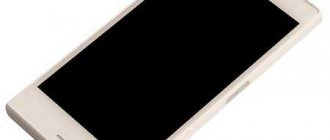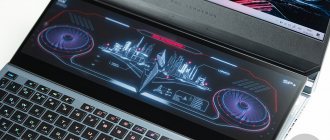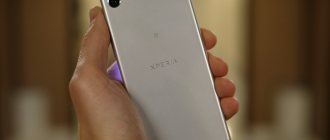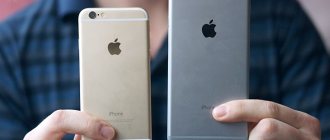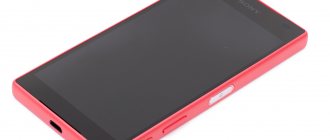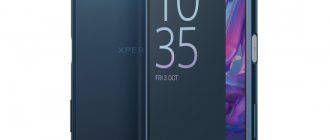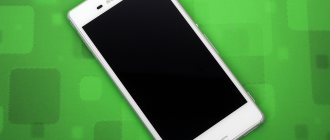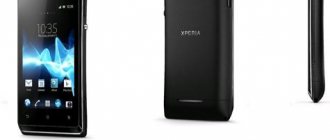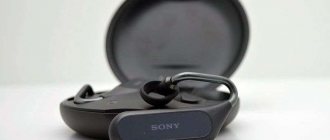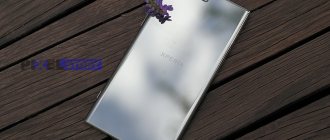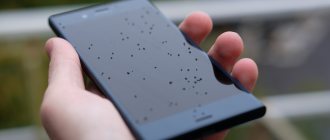Specifications Sony Xperia XZ2 Compact
- Screen: IPS, 5 inches, HDR10 support, FHD+ (2160x1080 pixels, pixel density 483 ppi) 18:9, Dynamic Contrast Enhancement, Corning Gorilla Glass 5 protective glass
- Chipset: 8-core Qualcomm Snapdragon 845 (SDM845), Hexagon 685 DSP coprocessor, Adreno 630 graphics accelerator
- RAM: 4 GB LPDDR4X
- Built-in memory: 64 GB, UFS 2.1, hybrid slot for microSD/HC/XC memory cards
- Main camera: Motion Eye, 19 MP, Exmor RS (1/2.3-inch optical size, 1.22 µm pixel), wide-angle G Lens, 25 mm, f/2.0 aperture, electronic stabilization, predictive hybrid autofocus, super slow-motion video 960 fps FHD, 4K HDR video
- Front camera: 5 MP, Exmor R (optical size 1/5 inch), EGF 23 mm, f/2.2 aperture
- Connectivity: Bluetooth 5.0, Wi-Fi 802.11 ac/b/g/n (2.4 GHz + 5 GHz), Miracast, Google Cast, DLNA, NFC, USB Type-C (USB 3.1 Gen. 1, 5 Gbps , OTG) Network: GSM/GPRS/EDGE (2G), UMTS HSPA+(3G), LTE (4G) Cat.18 (up to 1.2 Gbit/s)
- Navigation: GPS/GLONASS/BDS/Galileo/QZSS, A-GPS
- Connectors: USB type-C
- Battery: 2780 mAh, supports Qualcomm Charge fast charging
- Case material: glass, metal, plastic
- Operating system: Android 8.0 Oreo, proprietary Xperia UI shell
- Dimensions: 135 x 65 x 12.1 mm with a weight of 168 grams
- Features: dustproof and waterproof (IP65/IP68)
Sony Xperia XZ2 Compact review: a true compact flagship
Table of contents
- Introduction
- Specifications
- Packaging and equipment
- Appearance and design
- Display
- Hardware platform and performance
- Software and firmware
- Multimedia
- Wireless Interfaces and Communications
- File system
- Battery life
- Camera
- Comparison with competitors
- Conclusion
Introduction
Today, the segment of compact devices is fading into the background, and it is already difficult to find a new product with good hardware, small dimensions and a display that does not extend beyond five inches or more.
But there are exceptions to every rule. ]Sony[/anchor], known for its Xperia Compact series models, presented its next generation at the Mobile World Congress 2018 - the Sony Xperia XZ2 Compact. The new product is aimed at the conservative part of users who want to see top-end characteristics in small-sized devices.
Were their expectations met? The Sony Xperia XZ2 Compact smartphone is positioned in the flagship segment and offers a good set of characteristics. Particular attention is drawn to the display - five inches with FHD+ resolution, as well as the hardware, which we will talk about in more detail in the next section.
Next in the Sony Xperia XZ2 Compact review we will try to find out how good the device is in daily use.
announcements and advertising
2080 Super Gigabyte Gaming OC for 60 rubles.
Compeo.ru - the right comp store without any tricks
RTX 2060 becomes cheaper before the arrival of 3xxx
Ryzen 4000
series included in computers already in Citylink
The price of MSI RTX 2070 has collapsed after the announcement of RTX 3xxx
Core i9 10 series is half the price of the same 9 series
The price of memory has been halved in Regard - it’s more expensive everywhere
Technical specifications Sony Xperia XZ2 Compact
| Device type | Smartphone |
| Model | Sony Xperia XZ2 Compact |
| Housing materials | Glass + plastic + metal |
| Screen | 5.0″, IPS, 2160 x 1080 pixels |
| CPU | Qualcomm Snapdragon 845, 4 x 2.7 GHz + 4 x 1.7 |
| Video processor | Adreno 630 |
| operating system | Android 8.0 |
| RAM, GB | 4 |
| Built-in storage, GB | 64 |
| Memory card slot | Yes, up to 400 |
| Cameras, Mpix | Front: 5.0; Main: 19.0 |
| Battery, mAh | 2 870 |
| Dimensions, mm | 135.0 x 65.0 x 12.1 |
| Weight, g | 168 |
| price, rub. | ~50 000 |
We have a five-inch FHD+ display combined with a Qualcomm Snapdragon 845 processor. A set of 4 GB of RAM and 64 GB of main memory promises us quite comfortable work when performing various tasks. The battery is small, only 2,870, but the manufacturer promises us good battery life. There is fast charging. The cameras are also not bad, the main one is 19.0 MP and the front one is 5.0 MP. The smartphone supports Android Pay.
However, it’s time to check the dry numbers in practice, so let’s start a detailed examination with the packaging.
Packaging and accessories Sony Xperia XZ2 Compact
The gadget is presented in a classic Sony medium-sized box, in our case dark gray. The packaging, without any bright elements, looks strict. There is a nice design reference to the model on the front side. The model name is duplicated on the edges.
The reverse side is almost completely empty, with the exception of the lower part - there is a collection of technical and legal data. In general, the packaging looks neat, the cardboard is thick and durable, which means that the device remains protected during transportation.
In our case, a demo smartphone was provided for testing, which does not include the entire package. Having removed the cover, we should see the smartphone in a special backing, and under it a list with the following elements:
- charging block
- USB cable
- Adapter from USB Type-C to AUX
- documentation
Design, ergonomics
I admit, I don’t like the design of the new flagship Xperia line; it seems too reckless to abandon the fingerprint sensor button on the end and imitate trends. It’s as if Sony Mobile suddenly cut off a huge layer of their own developments in the field of design.
Therefore, the older Xperia XZ2 does not appeal to me at all. The same cannot be said about the Xperia XZ2 Compact, here Sony designers were able to prove that they still follow the principles of Sony Style.
The Xperia XZ2 Compact looks unassuming in pictures, but in the hand it feels like something incredible for the modern smartphone market. Only stubborn Japanese are capable of creating such a product in the era of iPhone X clones.
The smartphone has record-breaking compact dimensions for the top segment. It seems as if you are holding a technological piece of polished stone - monolithic, heavy, the back panel is slightly rough. It's difficult for me to describe the full feeling of using the Xperia XZ2 Compact, but it really is the most unusual device I've used in many years. No one does this, only Sony!
I won’t describe the location of the buttons; it’s better to look at the photos. Moreover, everything here is standard, in the Xperia style.
A sad innovation was the absence of a fingerprint sensor on the right side; it moved to the rear panel. It looks out of place, but Sony say their engineers couldn't fit it on the end - the side bezels around the screen are too thin.
Ergonomics.
Ease of use - the Xperia XZ2 Compact has no equal here. Now this is the most ergonomic smartphone with a screen covering almost the entire front panel. There is simply no other like it.
It's significantly smaller than the iPhone 8 or Galaxy S9. It can be compared to the iPhone SE, the only difference is that the XZ2 Compact will be much thicker than the small iPhone, but the screen is a whole inch larger.
The smartphone has full moisture protection, which has become the hallmark of Xperia flagships over the past years. You can safely take your phone with you to the bath or swimming pool. The main thing to remember is that protection only applies to fresh water.
Screen
The Xperia XZ2 Compact became the first smartphone in the compact line to have a normal screen installed, without reducing the resolution and quality of the matrix itself. This is a 5-inch FHD+ screen made using IPS technology.
The display quality is very high, as evidenced by HDR support and a maximum brightness of around 600 nits. The contrast is so high that the Xperia XZ2 Compact screen can be confused with OLED, the black color is very deep.
For those who don’t like bright colors by default, there is an opportunity to play around with color rendering to suit your needs. It is enough to switch the screen to sRGB mode (professional in the screen settings) to get the most truthful “picture”.
Sony tried to make an analogue of Always on Display. You pick up the phone and the XZ2 Compact's screen lights up, showing the time and notifications in black and white. It doesn’t look as impressive as on smartphones with OLED, but the implementation for an IPS screen is not bad, I liked it.
Price and main characteristics
At the Sony exhibition, the exact price of the flagship was not announced; it will become known already during the start of sales of the new product. The first batches of Xperia XZ2 will hit store shelves in early April.
Technical characteristics: • display: 5.7”, IPS FHD+ 2160*1080 px (424 ppi); • processor: Qualcomm Snapdragon 845 (2.8 GHz) + Adreno 630 video accelerator; • RAM: 4 GB; • internal memory: 64/128/256 GB + micro SDXC flash cards up to 400 GB; • camera: main – 19 MP, front – 5 MP; • communication: Wi-Fi 802.11 a/b/g/n/ac, Bluetooth 5.0 (aptX), GPS, A-GPS, GLONASS, LTE, NFC; • battery: 3180 mAh; • dimensions: 153 x 72 x 11.1 mm; • weight: 198 g.
The second generation of the Xperia line received the latest chipset from Snapdragon, a large widescreen display and stereo speakers. The gadget runs on Android 8.0 Oreo OS.
Camera
On paper, the Xperia XZ2 Compact's camera is identical to what we saw in the Xperia XZ1 or Xperia XZ Premium, but there's a catch.
The fact is that the Xperia XZ2 Compact is powered by the Snapdragon 845 chipset, which has a completely new image processing chip. Because of this, the quality of the photos should improve. Is it really?
Yes and no. In my opinion, the Xperia XZ2 Compact camera has become really better at daytime shooting, especially noticeable in cloudy weather. At night, the situation remained approximately the same - the Xperia flagships are still losing to their competitors in night photography. The lack of optical stabilization and not very high-aperture optics affects it.
But the new camera can shoot 960 fps video in FHD resolution, none of the A-brands can do that, maximum HD, and even then, the quality is much inferior to the Xperia XZ2/XZ2 Compact. This is cool, it’s a pity that there’s nowhere to use slow-mo photography in real life, you have to specifically look for some scenarios where it would be appropriate.
3D Creator, an application for creating 3D objects with a smartphone camera, has not gone away. A large post has been written about him, I advise you to read it.
The Xperia XZ2 Compact's biggest problem with the camera isn't really the hardware, which is fine, but the horribly outdated camera app. It’s simply disgusting to use them after the same Huawei P20 Pro or Galaxy S9.
Some greetings from 2014, this is unacceptable for a manufacturer of this class. I hope that this year Sony Mobile will show new software for the cameras of its flagships.
Review of the Sony Xperia XZ2 smartphone: a very expensive and powerful Japanese flagship
The Sony Xperia XZ2 and Xperia XZ2 Compact were first presented at MWC 2020 at the end of February. Innovative technologies are seamlessly combined with a completely new Ambient Flow design, which reflects the evolution of Sony design solutions. A vibrant Full HD+ HDR display, powerful stereo speakers and the new Dynamic Vibration System 2, as well as an improved Motion Eye camera that allows you to record video in 4K HDR and super slow motion (960 fps) in Full HD resolution, are complemented top-end Qualcomm Snapdragon 845 processor, providing high performance and energy efficiency. Read more about all this in our new review of the flagship smartphone Sony Xperia XZ2.
Key Features of Sony Xperia XZ2 (Model H8266)
- SoC Qualcomm Snapdragon 845, 8 cores (4 × Kryo 385 @2.8 GHz + 4 × Kryo 385 @1.8 GHz)
- GPU Adreno 630
- Operating system Android 8.0
- Touch display IPS 5.7″, 2160×1080 (18:9), 423 ppi
- Random access memory (RAM) 4 GB, internal memory 64 GB
- Nano-SIM support (2 pcs.)
- microSD support (up to 400 GB)
- GSM/GPRS/EDGE networks (850/900/1800/1900 MHz)
- WCDMA/HSPA+ networks (850/900/1900/2100 MHz)
- LTE Cat.18 FDD, TD networks
- Wi-Fi 802.11a/b/g/n/ac (2.4 and 5 GHz), Miracast, DLNA
- Bluetooth 5.0
- NFC
- GPS, A-GPS, Glonass, BDS, Galileo
- USB Type-C 3.1, USB OTG
- Main camera 19 MP, f/2.0, 4K video
- Front camera 5 MP, f/2.2
- Proximity and lighting sensors, magnetic field, accelerometer, gyroscope
- Fingerprint's scanner
- Protection IP65/68
- Battery 3180 mAh, Quick Charge 3.0
- Dimensions 153×72×11.1 mm
- Weight 198 g
| average price | find out prices |
| Retail offers | find out the price |
Appearance and ease of use
For the first time in a long time, Sony has truly changed something in the design of its smartphones: the company has been talking about changing its image for many years, but the design as a whole has remained virtually unchanged. Now, suddenly, the sharp corners and flat rear back have finally disappeared, the bodies of the new mobile flagships suddenly became sloping and pot-bellied, like brand new pieces of soap, just taken out of the packaging. Sony itself talks about a “completely new Ambient Flow design.”
Supporters of the “classic” design of Sony Xperia cried out, lovers of progress rejoiced. Now Japanese smartphones look completely different: there is the gloss of glass backs, and their very large rounding, allowing new products to slide off the table onto the floor on their own and without any help. It’s almost impossible to keep them on a flat, smooth surface; it’s time to use some kind of special rubberized mat.
However, it is better to wear a protective case, although the body of the Sony Xperia XZ2 is so thick (more than 11 mm) that you don’t want to thicken it even more. Finishing the conversation about ergonomics, we can add that the smartphone, for all its smoothness and roundness, is also very heavy - almost 200 g, which is really a lot for a pocket device. Especially when you consider that the battery here is not at all record-breaking, and it is unlikely that this is the reason for the heaviness of the new product.
I’m impressed that Sony didn’t follow fashion and didn’t make the notorious “bangs” copied by most manufacturers from Apple. The frame segments around the screen have become a little thinner compared to past times, but they are still wider than most modern devices on the market, although I don’t want to write this down as a disadvantage; the Sony Xperia XZ2 looks quite organic in terms of the ratio of the screen to the front panel. They didn’t forget to embed an LED event indicator above the screen.
Below the screen there is neither a row of hardware buttons nor a fingerprint scanner - you can barely make out only a thin slot for sound output from the main speaker. By the way, it works in a stereo pair with a top (spoken) speaker for dubbing music, movies and games; this is not news for Sony flagships.
All side keys are installed on the right side, the buttons are smooth, feel the same to the touch, and are widely spaced apart. The ride is quite elastic and clear. The camera control button is in its place.
The card slot (two Nano-SIM and one microSD) was suddenly made hybrid. This is unexpected and unpleasant. Some began to praise this solution for its ease of opening, but in order to transfer a SIM card to the Sony Xperia XZ2, you also need to disconnect the memory card. Previously, there was no need to touch the memory, the slots were spaced apart, this added reliability and protected against unexpected data loss. Now everything is like everyone else...
The card tray, by the way, can still be pulled out without the help of a paper clip, thanks for that. At the top end you can also find a small hole for an auxiliary microphone.
The main microphone is located at the bottom end, where the hole for the USB Type-C connector is located. And since we see USB Type-C, it’s easy to guess that there is no 3.5 mm audio output for headphones in the smartphone. However, the package includes an adapter, so you can connect any headphones to your smartphone right out of the box.
Sony has named the 4 colorways of the XZ2 as follows: Obsidian Black (black), Cool Silver (gray), Dark Emerald (dark green), and Ash Pink (gray pink). All colors are not bright, not flashy, they look solid and serious. The front panel under the glass is painted in a color that matches the overall color of the body.
The Xperia XZ2 is protected from water and dust, so it is not afraid of either rain or washing under the tap (however, the device is prohibited from being completely submerged under water).
Screen
The Sony Xperia XZ2 smartphone is equipped with an IPS display covered with 2.5D Corning Gorilla Glass 5 with sloping edges. The physical dimensions of the screen are 65x129 mm with a diagonal of 5.7 inches, aspect ratio 18:9. At the same time, the screen resolution is 2160x1080 with a pixel density of about 423 ppi. The frame around the screen has a thickness of 3.5 mm on the sides, 11 mm on the top, and 12 mm on the bottom.
It is possible to use automatic brightness adjustment based on the operation of the ambient light sensor. Multi-touch tests diagnose support for 10 simultaneous touches. Supports working with the screen while wearing gloves.
A detailed examination using measuring instruments was carried out by the editor of the “Monitors” and “Projectors and TV” sections Alexey Kudryavtsev
. Here is his expert opinion on the screen of the sample under study.
The front surface of the screen is made in the form of a glass plate with a mirror-smooth surface that is scratch-resistant. Judging by the reflection of objects, the anti-glare properties of the screen are better than those of the Google Nexus 7 (2013) screen (hereinafter simply Nexus 7). For clarity, here is a photograph in which a white surface is reflected in the switched off screens of both devices (Sony Xperia XZ2, as is easy to determine, is on the right; then they can be distinguished by size):
The Sony screen is noticeably darker (its brightness in the photo is 105 versus 115 for the Nexus 7). The tripling of reflected objects in the Sony Xperia XZ2 screen is very weak, this indicates that there is no air gap between the outer glass (also known as the touch sensor) and the surface of the matrix (OGS - One Glass Solution type screen). Due to the smaller number of boundaries (glass/air type) with very different refractive indices, such screens look better in conditions of intense external illumination, but their repair in the case of cracked external glass is much more expensive, since the entire screen has to be replaced. The outer surface of the screen has a special oleophobic (grease-repellent) coating (very effective, even better than that of the Nexus 7), so fingerprints are removed much more easily and appear at a lower speed than with regular glass.
When manually controlling the brightness and displaying the white field in full screen, its maximum value was about 600 cd/m², and the minimum was 6 cd/m². The maximum value is very high, and, given the excellent anti-glare properties, in bright daylight and even in direct sun the image on the screen should be clearly visible. In complete darkness, the brightness can be reduced to a comfortable level. Automatic brightness adjustment works based on the light sensor (it is located to the left of the front speaker slot). In automatic mode, as external lighting conditions change, the screen brightness both increases and decreases. The operation of this function depends on the position of the brightness adjustment, with which the user can try to set the desired brightness level in the current conditions. If you don’t change anything, then in complete darkness the auto-brightness function reduces the brightness to 6 cd/m² (a bit dark), in an office illuminated by artificial light (approximately 550 lux) it sets it to 160 cd/m² (normal), in a very bright environment (corresponds to the lighting on a clear day outdoors, but without direct sunlight - 20,000 lux or a little more) increases to 600 cd/m² (to the maximum, as needed). In the dark, we moved the adjustment slider a little to the right and for the three conditions indicated above we got 12, 165 and 600 cd/m², this combination suited us. It turns out that the auto-brightness function works adequately and allows the user to customize their work to individual requirements. Only at very low brightness levels does significant backlight modulation appear, but its frequency is high, about 2.3 kHz, so there is no visible screen flicker and is unlikely to be detected in a test for the presence of a stroboscopic effect.
This screen uses an IPS type matrix. The microphotographs show a typical IPS subpixel structure:
For comparison, you can see the gallery of microphotographs of screens used in mobile technology.
The screen has good viewing angles without inverting shades and without significant color shifts, even with large viewing deviations from perpendicular to the screen. For comparison, here are photographs in which the same images are displayed on the screens of the Nexus 7 and Sony Xperia XZ2, while the screen brightness is initially set to approximately 200 cd/m² (across the white field in the entire screen), and the color balance on the camera is forcibly switched to 6500 K .
White field perpendicular to the plane of the screens:
Note the good uniformity of brightness and color tone of the white field.
And a test picture:
The colors on the Sony Xperia XZ2 screen are oversaturated, skin tones are heavily red-shifted, and the color balance is noticeably different from the standard. Of course, you need to be very careful when assessing the color rendition of a screen from a photograph, but the trend is conveyed correctly.
Now at an angle of approximately 45 degrees to the plane and to the side of the screen:
It can be seen that the colors have not changed much on both screens, but on the Sony Xperia XZ2 the contrast has decreased to a greater extent due to the greater brightening of blacks.
And a white field:
The brightness at an angle for both screens decreased noticeably, but in the case of the Sony Xperia XZ2 the drop in brightness is less. When deviated diagonally, the black field is lightened to a medium degree and acquires a purple tint. The photographs below demonstrate this (the brightness of the white areas in the direction perpendicular to the plane of the screens is the same for the screens!):
And from another angle:
When viewed perpendicularly, the uniformity of the black field is average:
The contrast (approximately in the center of the screen) is high - about 1300:1. The response time for the black-white-black transition is 26 ms (15 ms on + 11 ms off). The transition between halftones of gray 25% and 75% (based on the numerical value of the color) and back takes a total of 38 ms. The gamma curve, constructed using 32 points with equal intervals based on the numerical value of the shade of gray, did not reveal any blockage in either the highlights or the shadows. The index of the approximating power function is 2.17, which is close to the standard value of 2.20, while the real gamma curve deviates little from the power dependence:
We did not detect the presence of dynamic adjustment of the backlight brightness in accordance with the nature of the displayed image, which is very good.
The color gamut is noticeably wider than sRGB and approaches DCI-P3:
Let's look at the spectra:
They are typical for top Sony mobile devices (and not only). Apparently, this screen uses LEDs with a blue emitter and green and red phosphor (usually a blue emitter and a yellow phosphor), which, in combination with special matrix filters, allows for a wide color gamut. Yes, and the red phosphor apparently uses so-called quantum dots. Unfortunately, as a result, the colors of images - drawings, photographs and films - oriented to the sRGB space (and these are the vast majority) have an unnatural saturation. This is especially noticeable on recognizable shades, such as skin tones. The result is shown in the photographs above.
The balance of shades on the gray scale is acceptable, since the color temperature is noticeably higher than the standard 6500 K, but the deviation from the blackbody spectrum (ΔE) is below 10 units, which is considered a good indicator for a consumer device (data labeled as Uncorrected in the graphs below) . At the same time, the variation in color temperature and ΔE is not very large - this has a positive effect on the visual assessment of color balance. (Dark areas of the gray scale can be ignored, since color balance there is not very important, and the error in measuring color characteristics at low brightness is large.)
This smartphone has the ability to adjust the color balance by adjusting the intensities of the three primary colors:
That's what we tried to do: the result is data signed as Corr. in the graphs above. As a result, we adjusted the color temperature and ΔE remained low. At the same time, the maximum brightness decreased to 490 cd/m², which is still tolerable. Additionally, the user can select one of the display modes:
By default, Standard mode . If you enable Extreme Brightness Mode , you get this result:
Color saturation is further enhanced, and contour clarity, luminance contrast, and color contrast are also improved. The color gamut in this mode also increases slightly:
And spectra:
It can be seen that there is very little cross-mixing of components, and due to this and good separation of components, a wide coverage is achieved. Unfortunately, the possible benefits of this are greatly reduced by inappropriately high color contrast, etc. There are definitely benefits from the Professional . This is what the test image looks like after enabling this mode:
Color saturation has returned to normal, the image looks natural (adjusted for what the camera transmits). Color gamut for this mode:
It can be seen that the coverage is close to sRGB. The triangle is a little crooked, that is, the correction is not entirely accurate, but these are minor things. And the corresponding spectrum:
The components are already significantly mixed with each other.
Therefore, to get the correct colors in common images, you need to select Professional and make color balance adjustments.
There is a setting that allows you to reduce the intensity of the blue component.
In this case, the statements about harm to health are not extreme, which, however, still does not add to the usefulness of this function. Let us recall that, in principle, bright light can lead to disruption of the circadian rhythm (see the article about the iPad Pro with a 9.7-inch display), but this problem can be solved by adjusting the brightness to a comfortable level, and distorting the color balance, reducing the contribution of blue, there is absolutely no point.
Let's summarize. The brightness adjustment range of this screen is very wide, the anti-glare properties are excellent, which allows you to comfortably use the smartphone both on a sunny day and in complete darkness. It is also possible to use a mode with automatic brightness adjustment, which works adequately. Other advantages include a very effective oleophobic coating, the absence of air gaps in the layers of the screen and flicker, high contrast, which does not decrease much when viewed at an angle to the screen plane, and the ability to obtain a color balance and sRGB gamut close to standard. There are probably no significant shortcomings; the quality of the screen is very high.
Camera
The front camera of the Sony Xperia XZ2 received a sensor with a resolution of 5 megapixels. The lens has an f/2.2 aperture and fixed focus. There is no flash of its own; its role is played by the bright backlight of the screen, which flashes at the moment of shooting. There is the possibility of manual settings, and in general, in daylight, the camera produces decent quality, but indoors, with a lack of light, the quality drops noticeably. This front camera clearly cannot compete with the 24-megapixel front camera of the new flagship Huawei P20 Pro.
The main camera on the Sony Xperia XZ2 is also not as unique as the unusual Leica triple camera on the Huawei P20 Pro. Here the camera has only one sensor, it is a 1/2.3-inch 19-megapixel Exmor RS sensor with memory for mobile devices with a pixel size of 1.22 microns, and a G Lens lens with an f/2.0 aperture. All the advanced technologies that a Sony mobile camera can boast of have migrated here from previous models. Predictive shooting automatically detects smiles and movement, starting to shoot even before you press the shoot button.
Only the last frame in this series was taken after pressing the shutter button
Bionz proprietary technology is responsible for image processing. It is possible to shoot continuously with autofocus tracking. The 3D model builder is now available not only for the main camera, but also for the front camera. Naturally, there is an advanced manual mode in which you can manually select light sensitivity (up to ISO 12800), shutter speed, focusing method and white balance. There is only no standard ability to shoot in RAW.
On the Xperia XZ2 you can shoot video in 4K HDR format, there is a shooting mode in 1080p at 60 fps. The advanced Motion Eye camera can now shoot super-slow motion with a frequency of 960 fps not only in HD format, as before, but also in Full HD, which no one else has yet (regular slow motion with a frequency of 120 fps is also implemented). The proprietary SteadyShot video stabilization technology with smart active mode (5-axis stabilization) is in place.
The shooting quality is high, the picture is bright and clear, fast autofocus works adequately, the sharpness across the frame is uniform, and the detail is high. The sound is also recorded clearly, the noise reduction system works adequately and does not produce distortion.
- Video No. 1 (25 MB, 1920×1080, slo-mo, H.264, AAC)
- Video No. 2 (66 MB, 3840× [email protected] fps, H.265, AAC)
- Video No. 3 (52 MB, 3840× [email protected] fps, H.265, AAC)
- Video No. 4 (73 MB, 1920× [email protected] fps, H.264, AAC)
Below are examples of photos taken with the main camera:
If the camera has enough light, the sharpness in the center of the frame is simply excellent. Unfortunately, the sharpness at the edges of the frame is always noticeably lower than in the center. If shooting takes place in the shade or in the evening, the picture quality drops noticeably. Noise reduction, in principle, works carefully, trying to eliminate noise only on homogeneous surfaces, leaving a small untouched area around contrasting edges, so that even in full-size the pictures look decent. However, this discrimination works well only with very contrasting
boundaries (such as wires against the sky), but the interweaving of bare tree branches is often blurred into mush by the noise suppressor. When shooting macro, the camera manages to focus on foreground objects and blur the background; the macro is also quite decent. The images are clearly lacking in dynamic range. It’s difficult to talk seriously about the quality of night shots, but the camera tries to raise the light sensitivity and reduce the shutter time, so if you shoot some illuminated objects, you can “pull” a 2-3 megapixel “postcard” out of the picture.
To summarize: the camera takes pictures very well in the light, but shooting in the shadows and in the evening deserves only an “average” rating; such pictures look normal only after being reduced (conditionally) to 5-7 megapixels. Night shots of illuminated objects should be reduced even further, to approximately the resolution of the smartphone screen. The smartphone will transmit “scenes from daytime city life” normally; there is no shame in sharing such photographs with friends, but everything that is not taken in the light can only be shown from the screen of the smartphone itself.
Telephone and communications
The Sony Xperia XZ2 platform supports high-speed LTE (4G) Cat.18 networks with data transfer rates of up to 1.2 Gbps. All three LTE FDD bands used in Russia are supported (Band 3, 7, 20). In practice, within the city limits of the Moscow region, the device demonstrates reliable operation in wireless networks, does not lose connection, and quickly restores connection after a forced interruption.
The device works adequately in both Wi-Fi bands (2.4 and 5 GHz), there are no complaints about the operation of the Wi-Fi module. You can organize a wireless access point via Wi-Fi or Bluetooth channels. There is also an NFC module that works great with Troika travel cards and the My Travel Card application.
The navigation module works with GPS (with A-GPS), and with the domestic Glonass, and with the Chinese Beidou (support for Galileo and QZSS is also announced). The first satellites, even during a cold start, are detected quickly, within the first seconds, and the positioning accuracy does not cause any complaints. The magnetic compass, necessary for navigation programs, is also in place.
The phone application supports Smart Dial, that is, while dialing a phone number, a search is immediately carried out by the first letters in contacts. Methods for setting up the sorting and display of contacts are standard for the Android interface; there is a blacklist for unwanted contacts. VoLTE supported. The vibration alert is average in power.
The Sony Xperia XZ2 platform is one of the very few that allows a smartphone to support both SIM cards in 4G mode at the same time in active standby mode, which has not previously been seen in mobile devices (4G + 3G at best). Smartphones based on Kirin 970 (for example, Huawei P20 Pro) can do this now, but perhaps no one else. The SIM card will standby on 4G voice even if another card is assigned to 4G data. The cards operate in Dual SIM Dual Standby mode, there is only one radio modem.
Software and multimedia
As a software platform, Sony Xperia XZ2 uses Google Android version 8.0 with its own shell. The design, organization, set of pre-installed applications - everything here is exactly the same as it was before; a regular user of Sony mobile technology will not find anything new here.
To play music, a familiar branded player is used with a familiar set of settings for optimizing ClearAudio+ and Clear Bass sound. The sound is quite loud and bright, it is organized using two front speakers and S-Force Front Surround technology.
The sound in headphones is also decent, the range of settings is so wide that you can adjust everything to your taste. There is a five-band equalizer with presets. Bluetooth 5.0 aptX/aptX HD audio/A2DPE profiles are supported. LDAC improves data transmission over Bluetooth, providing quality almost at the level of Hi-Res Audio. There is no built-in FM radio, and there is no voice recorder application in Sony smartphones either.
Performance
Sony Xperia XZ2 runs on the most advanced Qualcomm mobile platform - the Snapdragon 845 single-chip system. The chip is manufactured using a 10-nanometer process technology. The SoC configuration includes two clusters of four processor cores: Kryo 385 with a maximum frequency of up to 2.8 GHz (custom Cortex-A75) and Kryo 385 with a frequency of up to 1.8 GHz (custom Cortex-A55). The amount of RAM is 4 GB, the storage capacity is 64 GB. Of these, about 48.5 GB of flash memory is initially free.
Qualcomm Snapdragon 845 is the flagship platform of the mobile SoC market leader, one of the most powerful smartphone platforms. Judging by the tests, it not only traditionally leads in graphics tests, but also outperforms other top solutions in complex as well as browser-specific tests. Adreno 630 GPU supports OpenGL ES 3.2 and Vulkan APIs.
In real use scenarios, there are no obstacles for this SoC; it confidently copes with any tasks assigned to it. In particular, there are no problems with games: all the games we tested, including Modern Combat 3, Mortal Kombat X, Injustice 2, run confidently at maximum settings without the slightest slowdown. The Sony Xperia XZ2 is one of the most powerful smartphones available today and has plenty of performance headroom for future upgrades.
Testing in comprehensive tests AnTuTu and GeekBench:
For convenience, we have compiled all the results we obtained when testing the smartphone in the latest versions of popular benchmarks into tables. The table usually adds several other devices from different segments, also tested on similar latest versions of benchmarks (this is done only for a visual assessment of the obtained dry figures). Unfortunately, within the framework of one comparison it is impossible to present the results from different versions of benchmarks, so many worthy and relevant models remain “behind the scenes” - due to the fact that they once passed the “obstacle course” on previous versions of test programs.
| Sony Xperia XZ2 (Qualcomm Snapdragon 845) | Huawei P20 Pro (HiSilicon Kirin 970) | Meizu Pro 7 Plus (MediaTek Helio X30) | |
| AnTuTu (v7.x) (bigger is better) | 254916 | 209585 | 143077 |
| GeekBench (v4.x) (bigger is better) | 2396/8357 | 1906/6775 | 1415/5417 |
Testing the graphics subsystem in gaming tests 3DMark, GFXBenchmark and Bonsai Benchmark:
When testing in 3DMark, the most powerful smartphones now have the ability to run the application in Unlimited mode, where the rendering resolution is fixed at 720p and VSync is disabled (which can cause the speed to rise above 60 fps).
| Sony Xperia XZ2 (Qualcomm Snapdragon 845) | Huawei P20 Pro (HiSilicon Kirin 970) | Meizu Pro 7 Plus (MediaTek Helio X30) | |
| 3DMark Ice Storm Sling Shot ES 3.1 (bigger is better) | 3814 | 2963 | 1826 |
| 3DMark Sling Shot Ex Vulkan (bigger is better) | 3011 | 2918 | 1217 |
| GFXBenchmark Manhattan ES 3.1 (Onscreen, fps) | 54 | 39 | 14 |
| GFXBenchmark Manhattan ES 3.1 (1080p Offscreen, fps) | 55 | 39 | 22 |
| GFXBenchmark T-Rex (Onscreen, fps) | 60 | 60 | 52 |
| GFXBenchmark T-Rex (1080p Offscreen, fps) | 139 | 108 | — |
Testing in browser cross-platform tests:
As for benchmarks for assessing the speed of the javascript engine, you should always make allowance for the fact that their results significantly depend on the browser in which they are launched, so the comparison can only be truly correct on the same OS and browsers, and this is possible during testing not always. For Android OS, we always try to use Google Chrome.
| Sony Xperia XZ2 (Qualcomm Snapdragon 845) | Huawei P20 Pro (HiSilicon Kirin 970) | Meizu Pro 7 Plus (MediaTek Helio X30) | |
| Mozilla Kraken (ms, less is better) | 2385 | 3841 | 5106 |
| Google Octane 2 (bigger is better) | 17558 | 9311 | 8341 |
| SunSpider (ms, less is better) | 431 | 622 | 1017 |
AndroBench memory speed test results:
Thermal photographs
Below is a thermal image of the rear
surface obtained after 10 minutes of battery testing in the GFXBenchmark program:
The heating is clearly localized in the upper right part of the device, which apparently corresponds to the location of the SoC chip. According to the heat chamber, the maximum heating was 38 degrees (at an ambient temperature of 24 degrees), which is not very much.
Playing video
To test the omnivorous nature of video playback (including support for various codecs, containers and special features, such as subtitles), we used the most common formats, which make up the bulk of the content available on the Internet. Note that for mobile devices it is important to have support for hardware video decoding at the chip level, since it is most often impossible to process modern options using processor cores alone. Also, you shouldn’t expect a mobile device to decode everything, since the leadership in flexibility belongs to the PC, and no one is going to challenge it. All results are summarized in a table.
| Format | Container, video, sound | MX Video Player | Standard player |
| 1080p H.264 | MKV, H.264, 1920×1080, 24 fps, AAC | plays normally | plays normally |
| 1080p H.264 | MKV, H.264, 1920×1080, 24 fps, AC3 | plays normally | no sound |
| 1080p H.265 | MKV, H.265, 1920×1080, 24 fps, AAC | plays normally | plays normally |
| 1080p H.265 | MKV, H.265, 1920×1080, 24 fps, AC3 | plays normally | no sound |
Further testing of video playback was performed by Alexey Kudryavtsev
.
This unit does not appear to support DisplayPort Alt Mode for USB Type-C—outputting image and sound to an external device when connected to a USB port—as determined by using a USB Type-C to HDMI adapter (Choetech). Therefore, we had to limit ourselves to testing the output of video files on the screen of the device itself. To do this, we used a set of test files with an arrow and a rectangle moving one division per frame (see “Method for testing video playback and display devices. Version 1 (for mobile devices)”). Screenshots with a shutter speed of 1 s helped determine the nature of the output of frames of video files with various parameters: the resolution varied (1280 by 720 (720p), 1920 by 1080 (1080p) and 3840 by 2160 (4K) pixels) and frame rate (24, 25, 30, 50 and 60 fps). In the tests we used the MX Player video player in the “Hardware” mode. The test results are summarized in the table:
| File | Uniformity | Passes |
| 4K/60p (H.265) | Fine | a lot of |
| 4K/50p (H.265) | Fine | a lot of |
| 4K/30p (H.265) | Great | No |
| 4K/25p (H.265) | Great | No |
| 4K/24p (H.265) | Great | No |
| 4K/30p | Great | No |
| 4K/25p | Great | No |
| 4K/24p | Great | No |
| 1080/60p | Great | No |
| 1080/50p | Great | No |
| 1080/30p | Fine | No |
| 1080/25p | Fine | No |
| 1080/24p | Great | No |
| 720/60p | Great | No |
| 720/50p | Great | No |
| 720/30p | Great | No |
| 720/25p | Fine | No |
| 720/24p | Great | No |
Note: If both columns have Uniformity
and
Skips
are given green ratings, this means that, most likely, when watching films, artifacts caused by uneven alternation and skipping of frames will either not be visible at all, or their number and visibility will not affect the viewing comfort. Red marks indicate possible problems with playback of the corresponding files.
According to the criterion of frame output, the quality of playback of video files on the screen of the smartphone itself is very good, since frames or groups of frames can (but are not required) be output with more or less uniform alternation of intervals and without gaps. When playing video files with a resolution of 1920 by 1080 pixels (1080p) on a smartphone screen, the image of the video file itself is displayed exactly at the height of the screen (in landscape orientation), one to one in pixels, that is, in the original resolution. The brightness range displayed on the screen corresponds to the standard range of 16-235: in the shadows, only a couple of shades of gray do not differ in brightness from black, and in the highlights all gradations of shades are displayed. Note that this smartphone has support for hardware decoding of H.265 files with a color depth of 10 bits per color, while display output is also carried out in 10-bit mode (at least with fewer visible gradients than in the case of 8-bit). bit output). This, coupled with the wide color gamut, suggests that the claims are justified.
Battery life
The Sony Xperia XZ2 demonstrates a very high level of autonomy, although its battery capacity is smaller than that of most modern flagships. In real-life conditions of use under normal, average operating conditions, the hero of the review confidently survives until the evening charge.
Testing has traditionally been carried out at the usual level of power consumption without using power saving functions, although the device has them. Standard for Sony there are two modes - Stamina and Ultra Stamina. The battery efficiency is monitored by Smart Stamina and Battery Care technologies. Familiar Qnovo Adaptive Charging technology regulates current levels and continuously monitors the battery while charging to protect it from overload, helping to extend battery life.
| Battery capacity | Reading mode | Video mode | 3D Game Mode | |
| Sony Xperia XZ2 | 3180 mAh | 20:30 | 12:30 pm | 6:00 am |
| Huawei P20 Pro | 4000 mAh | 18:00 | 12:00 pm | 3:00 am |
| Meizu Pro 7 Plus | 3500 mAh | 14:10 | 10:00 am | 3 hours 20 minutes |
| Samsung Galaxy Note 8 | 3300 mAh | 15:00 | 12:00 pm | 4 hours 20 minutes |
| Meizu Pro 6 Plus | 3400 mAh | 17:30 | 12:30 pm | 4 hours 20 minutes |
Continuous reading in the FBReader program (with a standard, light theme) at a minimum comfortable brightness level (brightness was set to 100 cd/m²) lasted about 20.5 hours until the battery was completely discharged, and when continuously watching videos in high quality (1080p) with The device operates for more than 12 hours at the same brightness level via a home Wi-Fi network. In 3D gaming mode, the smartphone can work up to 6 hours, depending on the specific game.
Fast charging is supported; using its own AC adapter, the smartphone is fully charged in a little faster than 2 hours. Charging begins with a current of 1.3 A at a voltage of 8.5 V, then the current and voltage values are regulated by Qnovo Adaptive Charging technology. Wireless charging is supported, but the WCH20 wireless charging dock is not included and must be purchased separately.
Bottom line
Sony Xperia XZ2 is already presented on the Russian market. The price is high: for a Sony flagship in official Russian retail they ask for 60 thousand rubles, this is the maximum figure; for this or even less money you can buy flagship devices from Apple and Huawei. And the hero of the review is quite capable of competing with them; in terms of the most powerful and advanced hardware platform, the Xperia XZ2 is definitely in no way inferior to any of its competitors. Screen, autonomy, sound - everything is at a very high level, there is nothing to complain about. But when it comes to the camera, the Japanese flagship does not bypass either the iPhone X, or, even more so, the Huawei P20 Pro, which has taken the lead with its incredible unique triple camera capabilities. And yet, there are probably still many true fans of the Japanese brand, and even such an expensive smartphone as the Sony Xperia XZ2 will find its buyer.
Software
The Xperia XZ2 Compact runs on Android 8.0 Oreo with the latest version of the proprietary Xperia UI shell, but I admit, I didn’t notice any noticeable changes compared to last year’s Xperia XZ1 and XZ1 Compact.
We adjusted the system settings a little, tidied up the icons and items a little, and that’s all. Visually the same shell.
Of the real innovations, only the analogue of Always On Display, which was described above, as well as Xperia Actions. Using this application, you can configure various scenarios for using your smartphone, see the screenshots below for understanding:
Specifications
| Size: | 72x153x11.1 mm; |
| Weight: | 198; |
| Capacity: | RAM 4 GB; internal memory 64 GB (expandable via microSD up to 400 GB); |
| Display: | 5.7 inches, touch capacitive display, 2160x1080; |
| CPU: | Qualcomm Snapdragon 845, 2.8 GHz, 8 cores; |
| Camera: | 19 MP, autofocus, laser, LED flash, 4K video; |
| Battery: | Non-removable battery 3180 mAh; |
| Operating system: | Android 8.0; |
Performance, operating time
The performance of the Sony Xperia XZ2 Compact is absolutely fine. The Snapdragon 845 chipset with Adreon 630 graphics and fast UFS 2.1 memory leave no chance for lags/slowdowns.
The smartphone can easily claim the title of the fastest among Android devices. You notice this both when working with the launcher and specific applications. Just a bullet!
Benchmark results:
I almost forgot, the smartphone practically does not get warm in everyday use. You need to try with resource-intensive games to achieve noticeable heating.
Autonomy.
The operating time against the backdrop of super-speed is no longer so pleasing. The Xperia XZ2 Compact does not surprise with its autonomy, but it is quite capable of delivering 4.5-5 hours of screen on on a single charge.
In my usage scenario (a lot of music through wireless headphones, YouTube for 1-2 hours, social networks and constant Twitter), the device lasted until late at night, and even 10-15% remained in the morning. It’s stupid to want more from a 2780 mAh battery.
Display Xperia XZ2 Compact
The screen is the main factor that distinguishes a smartphone from its competitors. It has a 5-inch diagonal; everyone has long forgotten about this format. In my opinion, it is much more convenient to watch movies and play games on a large 18:9 screen, but this format should not be ignored, in any case, it has its fans. Moreover, the characteristics of the Sony XZ2 Compact display are pleasantly surprising - the picture turns out to be very rich, and the high brightness margin ensures comfortable operation of the phone even in sunny weather.
The high detail of the image is also pleasing thanks to the use of FullHD+ resolution, which gives an excellent pixel density per inch. When viewing photos and favorite films, the image turns out to be even better thanks to the HDR format.
A review of the Sony Xperia XZ2 Compact 2020 showed that in the settings menu you can specify your white balance parameters and choose one of three possible color rendering options:
- Professional;
- Standard;
- Maximum brightness mode.
High sensitivity mode allows you to use your smartphone without taking off your gloves. A useful opportunity for residents of cold regions. There is a night mode and you can set it to turn on on a schedule or automatically when it gets dark. The display is covered with a high-quality oleophobic coating, from which fingerprints can be easily removed.
Communication, sound
There are no complaints about the quality of cellular communications and voice transmission during conversations. Due to its small size, you always hold the XZ2 Compact properly so that you can be clearly heard. The noise reduction copes even with strong gusts of wind; I don’t remember any complaints about this.
The sound is also, surprisingly, wonderful. Compactness did not stop Sony Mobile engineers from installing very high-quality and loud stereo speakers in the Xperia XZ2 Compact. Probably the first Xperia phone in my memory that has excellent sound from the speakers.
Everything is simpler with headphones. The device did not receive a separate DAC for audio processing, so it can only rely on the audio chip built into the Snapdragon 845. Sony's wireless sound, as always, is at the highest level, Bluetooth 5.0 and the LDAC codec provide top sound quality over a wireless connection, the main thing is to buy the appropriate Sony headphones. For example, h.ear in 2 or h.ear on 2 Wireless NC.
Performance
The technical specifications of the Sony Xperia XZ2 Compact are based on the flagship Snapdragon 845 processor, which is the most powerful to date. There is not much RAM - 4 GB, but due to good optimization of the shell, this volume turned out to be plenty. The smartphone flies no matter what tasks you try to load it with and occupies the top positions in Antutu, scoring 267,000 points.
While reviewing the Sony Xperia XZ2 Compact, I did not forget about testing it in games, where it performed very well. You don’t expect anything else from its hardware - in Tanks, fps remains stable at around 60 frames on the highest graphics. Injustice 2 loads quickly and does not slow down even during dynamic scenes. The device easily played PUBG, which recently came out on mobile platforms. Although there are still enough problems in the game itself, this is a question for its developers.
Sony Xperia XZ2 Compact test in Antutu
The Sony XZ 2 Compact smartphone copes with any games and runs them at maximum graphics, what can we say about the interface, which simply flies here. All applications open without delay, scrolling in the browser occurs smoothly and without jerks.
